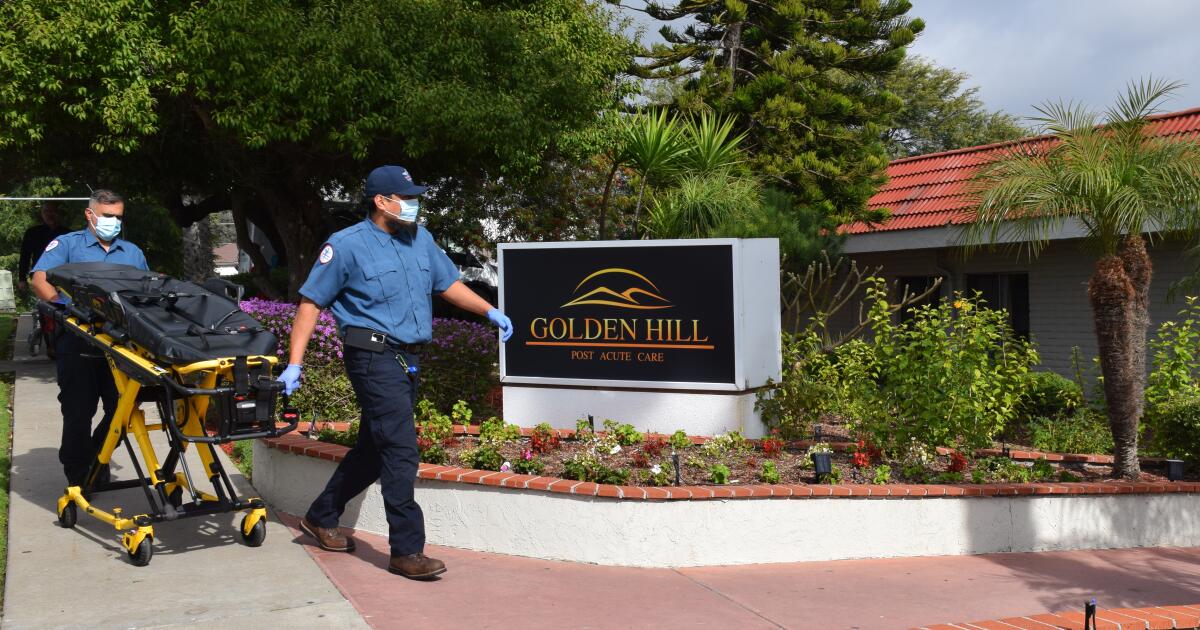

Flood damage forced the evacuation of Golden Hill Post Acute Care, a skilled nursing facility in San Diego, Thursday.
Workers loaded patients in wheelchairs and on gurneys into medical transport vans, gradually emptying the building on 34th Street of occupants and driving them to other nursing homes so that repairs can be made.
Operations manager Kile Whimpey said moving patients out of the 99-bed building near San Diego’s South Park neighborhood became necessary after its “physical plant began to show signs of impact from the recent heavy rains we have been experiencing in San Diego County.”
“We mobilized immediately to ensure that the residents of the Golden Hill community and those who serve them were out of harm’s way,” Whimpey said in an email. “It was determined that the most effective way to (accomplish) that goal was to transfer the residents out of the building and temporarily relocate them to clinically appropriate receiving facilities.”
In a statement sent by email late Thursday afternoon, the California Department of Public Health, which regulates skilled nursing facilities statewide, said it was aware of the evacuation and was “working with local authorities to coordinate proper patient transfer and care.”
Whimpey said that the evacuation is expected to wind up soon.
“This transition is continuing, and we expect that all residents will be settled into their new locations within the next 24 hours,” he said, adding that repairs are expected to take between three and five months.
“Of course, the facility will only reopen at such time as it is completely safe from a physical and environmental standpoint.”
Several people who asked to remain anonymous said Thursday that asbestos was detected at Golden Hill, indicating that the presence of the potentially harmful substances played a roll in the need to evacuate. Whimpey did not respond Thursday evening to follow-up questions about asbestos. According to state records, the facility was first licensed in 1969.
But it is clear that testing for asbestos is a regular part of flood recovery.
That’s because Rule 1206, a regulation of the San Diego Air Pollution Control District, requires asbestos testing for any demolition project in a building with more than four units.
Sodden building materials, from floor tiles to drywall, often must be removed and disposed of after a flood, and those that were manufactured before 1980 often contain asbestos, which is safe if left undisturbed but dangerous when demolished if the dust that such work generates is not kept out of lungs.
Vicky Boyle Dobbie, a regional account manager for First Onsite Property Restoration, a multi-state firm that specializes in helping commercial property owners recover from flood damage, said that while she had no personal knowledge of the Golden Hill Post Acute situation, there has been a lot of asbestos testing going on as companies work all-out to dry soaked buildings.
The demand for asbestos testing has been so great, she said, that customary turnaround times have been affected.
“We have some partners where, if we get them out early enough in the day, we can get results back same day,” Dobbie said. “Right now, they’re so inundated that you’re looking at 24 to 48 hours.”
Golden Hill is rated four of five stars by Nursing Home Compare, a ratings service run by the U.S. Centers for Medicare and Medicaid Services. But the facility had a comparatively high number of complaints during the COVID-19 pandemic. A San Diego Union-Tribune analysis published in 2023 which examined state records found that Golden Hill had the fifth-greatest number of complaints per bed from 2019 to 2022.







